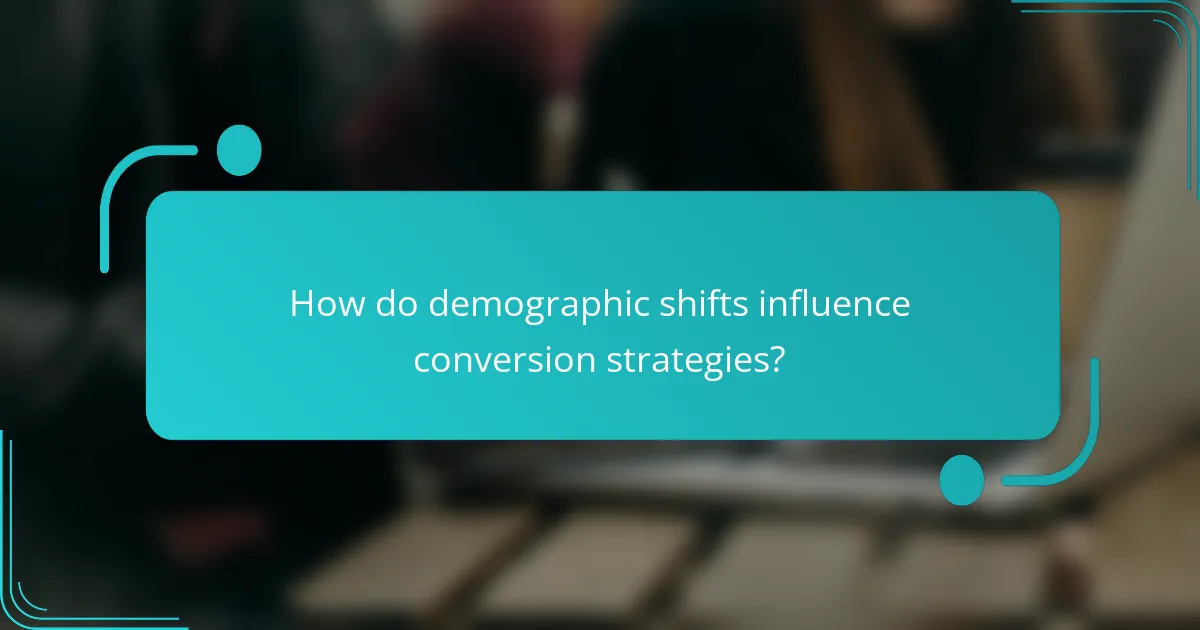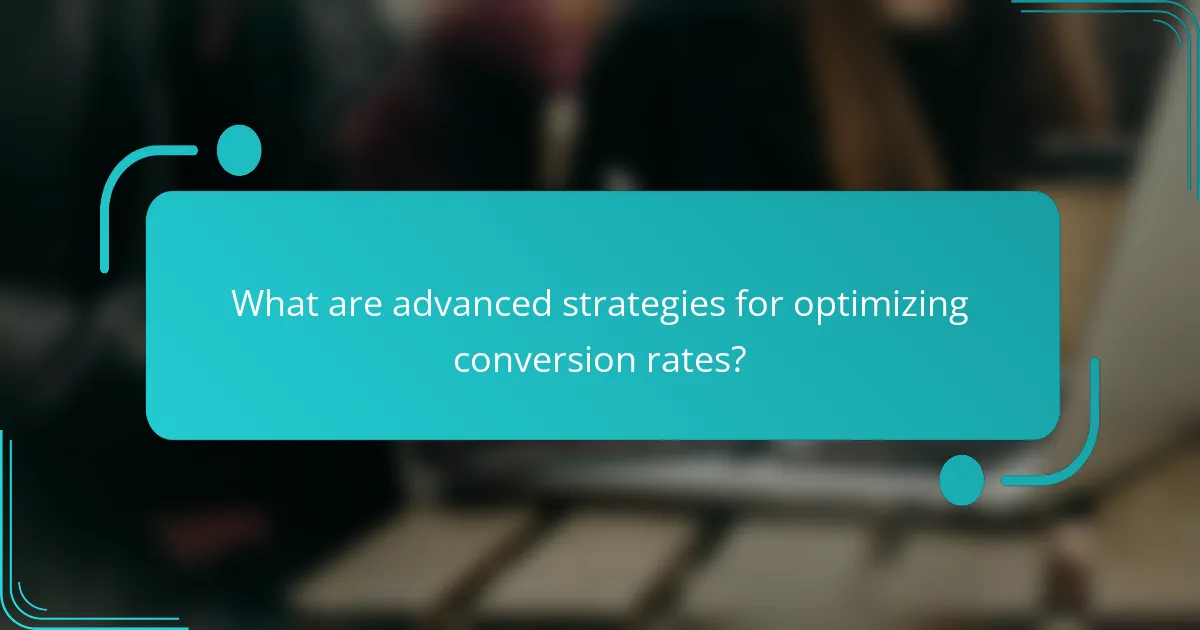Analyzing US market trends is crucial for businesses aiming to improve their conversion rates by aligning their marketing strategies with evolving consumer preferences. Key trends such as the rise of mobile commerce, a focus on personalization, and a growing demand for sustainable products can significantly influence customer engagement and sales outcomes. By understanding these dynamics, companies can effectively tailor their offerings and optimize their sales processes to meet the diverse needs of their target audiences.

How can US market trends improve conversion rates?
US market trends can significantly enhance conversion rates by aligning marketing strategies with consumer preferences and behaviors. By analyzing these trends, businesses can tailor their offerings and optimize their sales processes, leading to increased customer engagement and sales.
Utilizing data analytics tools
Data analytics tools are essential for understanding market trends and consumer behavior. These tools can track user interactions, sales patterns, and demographic information, providing valuable insights that drive decision-making. Popular platforms like Google Analytics and Tableau can help businesses visualize data and identify key trends.
To effectively utilize these tools, focus on metrics that matter most to your business, such as conversion rates, customer acquisition costs, and user engagement levels. Regularly review and adjust your strategies based on the data to stay aligned with market shifts.
Implementing A/B testing strategies
A/B testing allows businesses to compare two versions of a webpage or marketing campaign to determine which performs better. This method helps identify elements that resonate with consumers, such as headlines, images, or call-to-action buttons. By systematically testing these variables, companies can make data-driven decisions that enhance conversion rates.
Start with small changes to your website or marketing materials, and ensure you have a sufficient sample size for reliable results. Aim for a testing period of at least a few weeks to capture meaningful data, and be prepared to iterate based on what you learn.
Leveraging consumer behavior insights
Understanding consumer behavior is crucial for improving conversion rates. Insights into how customers make purchasing decisions can inform marketing strategies and product offerings. Analyzing factors such as shopping habits, preferences, and pain points can help businesses tailor their approach to meet customer needs.
Consider using surveys, focus groups, or social media listening tools to gather insights directly from your target audience. This qualitative data can complement quantitative analytics, providing a fuller picture of market trends and consumer expectations.

What are the key US market trends affecting conversions?
Key US market trends impacting conversions include the rise of mobile commerce, increased emphasis on personalization, and a shift towards sustainable products. Understanding these trends can help businesses optimize their strategies to improve conversion rates effectively.
Rise of mobile commerce
The rise of mobile commerce is transforming how consumers shop, with a significant portion of online purchases now occurring on smartphones. Businesses must ensure their websites are mobile-friendly, with fast loading times and easy navigation to capture this audience.
To enhance mobile conversions, consider implementing features like one-click purchasing and mobile-optimized checkout processes. Additionally, utilizing mobile payment options such as Apple Pay or Google Wallet can streamline transactions and reduce cart abandonment rates.
Increased emphasis on personalization
Personalization is becoming essential for driving conversions, as consumers expect tailored experiences based on their preferences and behaviors. Utilizing data analytics to understand customer demographics and shopping habits can help businesses create personalized marketing strategies.
Effective personalization tactics include targeted email campaigns, product recommendations based on past purchases, and dynamic website content that adjusts to user profiles. Implementing these strategies can significantly enhance customer engagement and boost conversion rates.
Shift towards sustainable products
Consumers are increasingly prioritizing sustainability in their purchasing decisions, leading to a growing demand for eco-friendly products. Businesses that highlight their commitment to sustainability can attract environmentally conscious consumers and improve conversion rates.
To capitalize on this trend, consider offering sustainable product lines, transparent sourcing practices, and eco-friendly packaging. Communicating your sustainability efforts through marketing channels can resonate with consumers and encourage them to choose your brand over competitors.

How do demographic shifts influence conversion strategies?
Demographic shifts significantly affect conversion strategies by altering consumer preferences and behaviors. Understanding these changes allows businesses to tailor their marketing efforts and optimize their sales processes to better meet the needs of different age groups.
Millennial spending habits
Millennials tend to prioritize experiences over material goods, often spending on travel, dining, and entertainment. Brands targeting this demographic should emphasize value and quality in their offerings, as well as align with social causes that resonate with their values.
Additionally, Millennials are highly influenced by online reviews and social media. Businesses should leverage user-generated content and testimonials to build trust and encourage conversions, as this age group often seeks validation from peers before making purchases.
Gen Z’s online shopping preferences
Gen Z shoppers are digital natives who favor seamless online experiences and quick access to information. They prefer brands that offer personalized shopping experiences and utilize social media platforms for product discovery, making it essential for businesses to maintain a strong online presence.
Moreover, Gen Z values sustainability and ethical practices. Companies should highlight their commitment to environmental responsibility and transparency in their supply chains to attract this socially conscious demographic. Engaging content that reflects these values can significantly enhance conversion rates among Gen Z consumers.

What role does social media play in US market trends?
Social media significantly influences US market trends by shaping consumer behavior and driving engagement. Platforms like Instagram, Facebook, and TikTok serve as vital channels for brands to connect with their audience, promote products, and gather insights into market preferences.
Impact of influencer marketing
Influencer marketing leverages the reach and credibility of social media personalities to promote products. Brands often collaborate with influencers who align with their target demographics, leading to authentic endorsements that can enhance brand visibility and trust.
Effective influencer partnerships can yield high engagement rates, with some campaigns achieving conversion rates significantly above traditional advertising methods. Brands should consider factors like follower demographics and engagement metrics when selecting influencers to ensure alignment with their marketing goals.
Trends in social commerce
Social commerce is rapidly evolving in the US, integrating shopping features directly into social media platforms. Users can browse and purchase products without leaving the app, streamlining the shopping experience and increasing impulse buys.
Key trends include the rise of shoppable posts and live shopping events, where brands showcase products in real-time. Companies should focus on creating engaging content that encourages interaction and drives sales, while also monitoring analytics to refine their strategies based on consumer behavior.

What are effective criteria for analyzing market trends?
Effective criteria for analyzing market trends include understanding consumer behavior, monitoring economic indicators, and assessing technological advancements. These elements help businesses identify opportunities and threats in the market, ultimately leading to improved conversion rates.
Identifying target audience segments
Identifying target audience segments involves breaking down the market into distinct groups based on demographics, interests, and purchasing behaviors. This segmentation allows businesses to tailor their marketing strategies to meet the specific needs of each group, enhancing engagement and conversion potential.
To effectively identify these segments, consider using surveys, social media analytics, and customer feedback. For example, a company may find that millennials prefer online shopping while older generations favor in-store experiences, prompting different marketing approaches.
Evaluating competitor strategies
Evaluating competitor strategies is crucial for understanding market positioning and identifying best practices. By analyzing what competitors are doing well, businesses can adapt successful tactics or differentiate their offerings to attract more customers.
Monitor competitors through their marketing channels, pricing strategies, and customer engagement techniques. For instance, if a competitor uses a subscription model successfully, it may be worth exploring a similar approach or finding a unique twist that appeals to your audience.

How can businesses adapt to emerging trends for better conversions?
Businesses can enhance conversion rates by closely monitoring and adapting to emerging market trends. This involves leveraging new technologies and data analytics to understand customer behavior and preferences more effectively.
Incorporating AI-driven insights
AI-driven insights allow businesses to analyze vast amounts of data quickly, identifying patterns that can inform marketing strategies. By using machine learning algorithms, companies can predict customer behavior and personalize experiences, leading to higher conversion rates.
For example, e-commerce platforms can utilize AI to recommend products based on past purchases and browsing history, increasing the likelihood of additional sales. Businesses should consider investing in AI tools that integrate seamlessly with their existing systems to maximize efficiency.
Utilizing real-time data tracking
Real-time data tracking enables businesses to monitor customer interactions as they happen, allowing for immediate adjustments to marketing strategies. This approach helps identify which campaigns are performing well and which need optimization, ensuring resources are allocated effectively.
For instance, using analytics tools to track website traffic and user engagement can reveal trends in customer preferences. Companies should implement dashboards that provide instant insights, enabling quick decision-making to capitalize on emerging opportunities.

What are advanced strategies for optimizing conversion rates?
Advanced strategies for optimizing conversion rates focus on understanding user behavior, enhancing website usability, and employing data-driven techniques. By implementing targeted tactics, businesses can significantly improve their conversion rates and drive more sales.
Utilizing A/B Testing
A/B testing involves comparing two versions of a webpage to determine which one performs better in terms of conversion rates. By systematically testing elements like headlines, images, and call-to-action buttons, businesses can identify what resonates most with their audience.
To effectively conduct A/B tests, ensure you have a clear hypothesis and a sufficient sample size to achieve statistically significant results. Common pitfalls include testing too many variables at once or running tests for insufficient time, which can lead to inconclusive outcomes.
Enhancing User Experience (UX)
Improving user experience is crucial for boosting conversion rates. A well-designed website that is easy to navigate can significantly reduce bounce rates and encourage users to complete desired actions, such as making a purchase or signing up for a newsletter.
Key aspects of UX include fast loading times, mobile optimization, and intuitive navigation. For example, aim for page load times under three seconds and ensure your site is responsive across devices. Regularly gather user feedback to identify areas for improvement.
Implementing Personalization Techniques
Personalization techniques tailor the user experience based on individual preferences and behaviors, leading to higher conversion rates. This can include personalized product recommendations, targeted email campaigns, and dynamic content that adapts to user interactions.
To implement effective personalization, utilize data analytics to understand customer behavior and preferences. However, be cautious not to over-personalize, as this can lead to privacy concerns and may alienate some users. Aim for a balance that enhances user engagement without compromising trust.
Leveraging Social Proof
Social proof, such as customer reviews, testimonials, and case studies, can significantly influence potential buyers’ decisions. By showcasing positive feedback and user experiences, businesses can build credibility and trust, which are essential for increasing conversion rates.
To effectively leverage social proof, prominently display reviews on product pages and include testimonials in marketing materials. Consider using trust badges and showcasing user-generated content to further enhance credibility. Aim for a mix of quantitative ratings and qualitative testimonials to appeal to different customer preferences.
